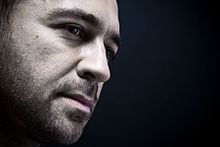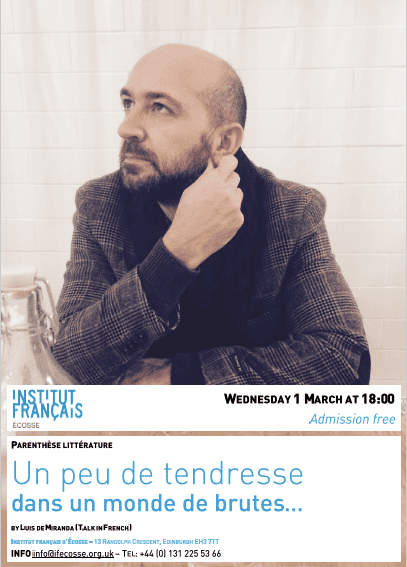Name Luis Miranda | Role Novelist | |
 | ||
Alternatives sean starrs david hynes and luis de miranda
Luis de Miranda PhD., (born 1971) is a philosopher and novelist. Born in Portugal, he grew up and has lived most of his life in Paris. He began travelling the world alone at the age of sixteen including Africa, Asia, Europe and the United States where he lived for two years. While living in New York City, he wrote his first novel, Joy (Joie).
Contents
- Alternatives sean starrs david hynes and luis de miranda
- The Foundations of Spanish American Poetry Luis de Miranda Bernardo de Balbuena and Pedro de Oa
- PhD Research
- Crealism
- Who Killed The Poet 88 Translations
- Novels
- Philosophical essays
- Films
- References

An author of thirteen books his writing has been translated into English, Arabic, Spanish, Turkish. He has published influential opinion articles in major French newspapers: his analysis of Facebook in France's leading newspaper Le Monde, has been shared more than 1400 times on Facebook. Luis de Miranda was the first French intellectual to react to the Dominique Strauss-Kahn scandal in 2011 in an internationally commented article published by mainstream newspaper Libération. In 2010 he wrote and directed a short movie where Nietzsche meets Jesus, seen by over 37,000 people and heavily commented upon on YouTube.
He holds a postgraduate degree in philosophy (DEA) from Pantheon-Sorbonne University and another in economy and management from HEC Paris.
He was formerly the editorial director of and co-managed the independent publishing press Max Milo Éditions from 2004 to 2012.
During the 2000 decade he gathered his literary and philosophical projects under the name of "Crealism" and created a related movement in 2007. Arsenal du Midi, his virtual writing laboratory from 2004 to 2007, used one of two anagrammatic signatures "Arsenal du Midi" and "Animal du Désir".
His philosophical essays develop a specific interest for societal issues, historical methods, technological devices, and process philosophy (Deleuze, Bergson). He has written a cultural history of neon signs (L'être et le néon), a widely reviewed and influential cultural history of digital devices and automata (L'art d'être libres au temps des automates), presented by the magazine Sciences Humaines as "a new utopia", "both philosophical, literary, artistic and scientific, an analysis of the Lacanian concept of jouissance in relation with capitalism, and a study on Deleuze which was translated and published by the Edinburgh University Press (Deleuze Studies). In all of these he develops his concept of 'Creal', which designates a form of ethical creative absolute becoming.
In August 2017 he was awarded his Doctor of Philosophy (PhD) from the University of Edinburgh where his thesis explored the concept of esprit de corps. While studying for his doctorate he was also the founder and director of the CRAG (Creation of Reality Group) and the Anthrobotics Cluster.
The Foundations of Spanish American Poetry: Luis de Miranda, Bernardo de Balbuena and Pedro de Oña
PhD Research
From September 2014 to March 2017 Luis de Miranda conducted his PhD research on the concept of esprit de corps at the University of Edinburgh from a historical, political, philosophical, and comparative perspective. He explored the ideas of collective life and the hive mind from a discourse analysis and conceptual history perspective, comparing long-term data since the eighteenth century until the present day. The University of Vienna invited Luis de Miranda to talk about his research in April 2016 and published his paper online.
His research focused on the question What is Life?, process philosophy, social creation, discourse analysis, cultural and conceptual history and French philosophy, with an emphasis on Deleuze (and Guattari), Lacan, Bergson, Foucault. His concept of 'Creal', explores a form of post-anthropocentric creativity, and notions as (collective) agency, autonomy, subjectivity, social practices, biotechnologies, and esprit de corps.
As part of his research he was also the co-founder and director of The Crag (Creation of Reality Group), an interdisciplinary community of interest on creation and/of reality and founder of the Anthrobotics Cluster, "a platform of cross-disciplinary research that seeks to investigate some of the biggest questions that will need to be answered" on the relationship between humans, robots and intelligent systems and "a think tank on the social spread of robotics, and also how automation is part of the definition of what humans have always been", "a hybrid unity made of flesh and protocols, creation and creature".
His philosophical essay "Is a new life possible?" co-translated into English has been published as a peer-reviewed essay by the Edinburgh University Press (Deleuze Studies). It remains one of the most downloaded Deleuze Studies papers since 2013, and is an attempt to present an overview of Deleuze's philosophy through the concept of lines of life. In his dialogues with Claire Parnet, Deleuze asserts that: "Whether we are individuals or groups, we are made of lines" (Deleuze and Parnet 2007: 124). In A Thousand Plateaus (with Guattari), Deleuze calls these kinds of 'lifelines' or 'lines of flesh': break line (or segmental line, or molar line), crack line (or molecular line) and rupture line (also called line of flight) (Deleuze and Guattari 2004a: 22). Luis de Miranda explains the difference between these three lines, how they are related to the 'soul', and how a singular individual or group can arise from the play of the lines. Eventually, he introduces the concept of 'Creal' to develop the Deleuzian figure of the 'Anomal', the so(u)rcerer.
Crealism
"The relationship between crealism and digitalism [numérisme] is the dialectic of the 21st century". Largely born out of his readings of Jacques Lacan, Karl Marx, Gilles Deleuze and Martin Heidegger between 2003-2007, The Creal or Crealism is Luis de Miranda's proposed answer to the philosophical problem of the Real. "Creal is obviously a portmanteau compound of created-real. At the same time, I elaborated on the concept in an essay on Deleuze (Is a New Life Possible?). A philosophical concept answers a question and Creal is my answer to the question What is more real than the Real?".
Who Killed The Poet? & 88 Translations
In Spring 2017 to coincide with the imminent publication of the English translation of Qui a tué le poète? Luis de Miranda launched a world literature project to assemble eighty-eight translations of his novella. It's aim is to explore the "transnational existential grammar of the book and its universal themes, which although written in differing languages and using their own poetry describe the same human emotions. In an interview with World Literature Today, Luis de Miranda described the project as "reawakening a sort of universal reader". Who Killed The Poet? was translated by Tina Kover and joins the already published Turkish edition with Greek, Hindi, Korean and Swedish translations on their way.
